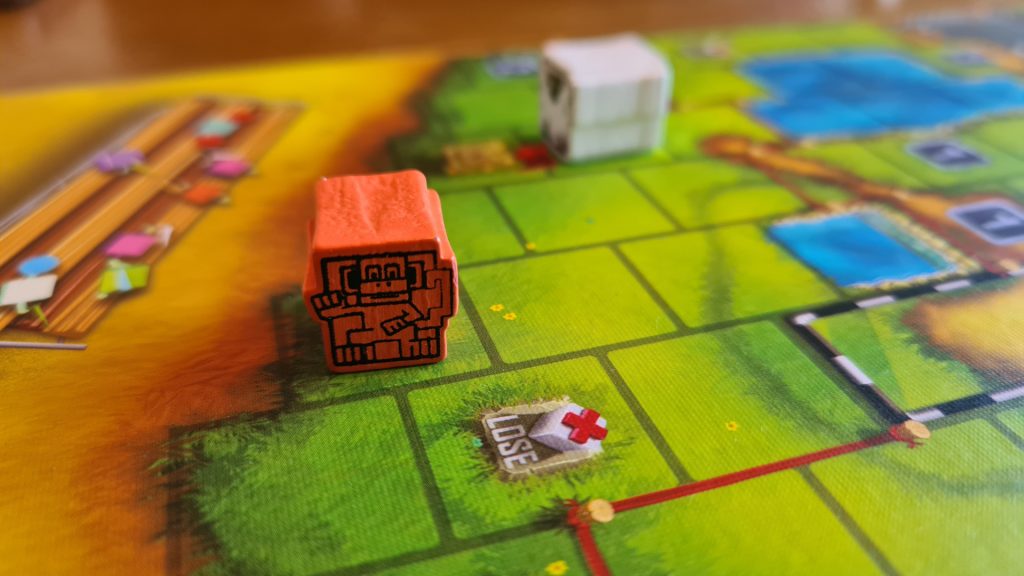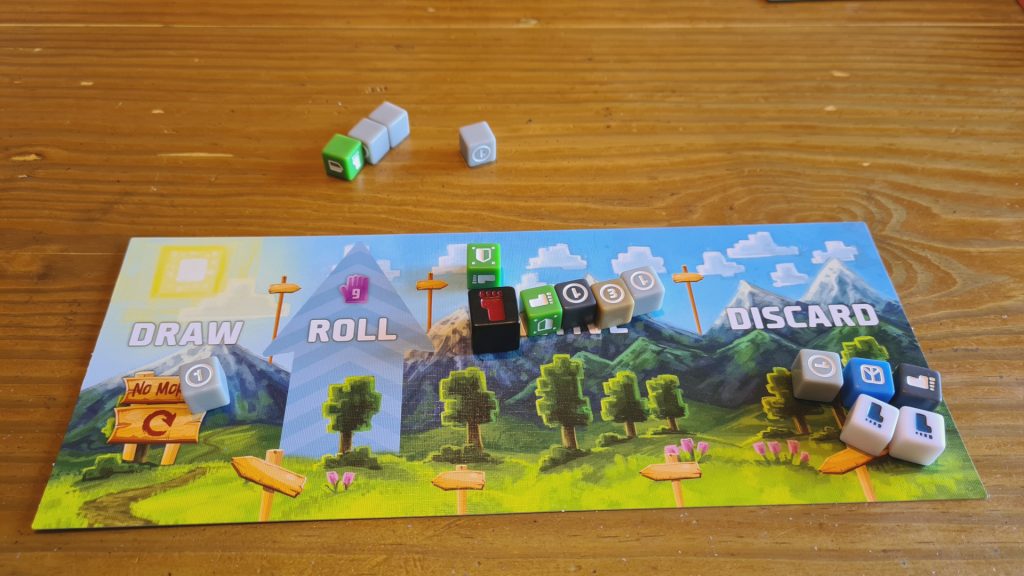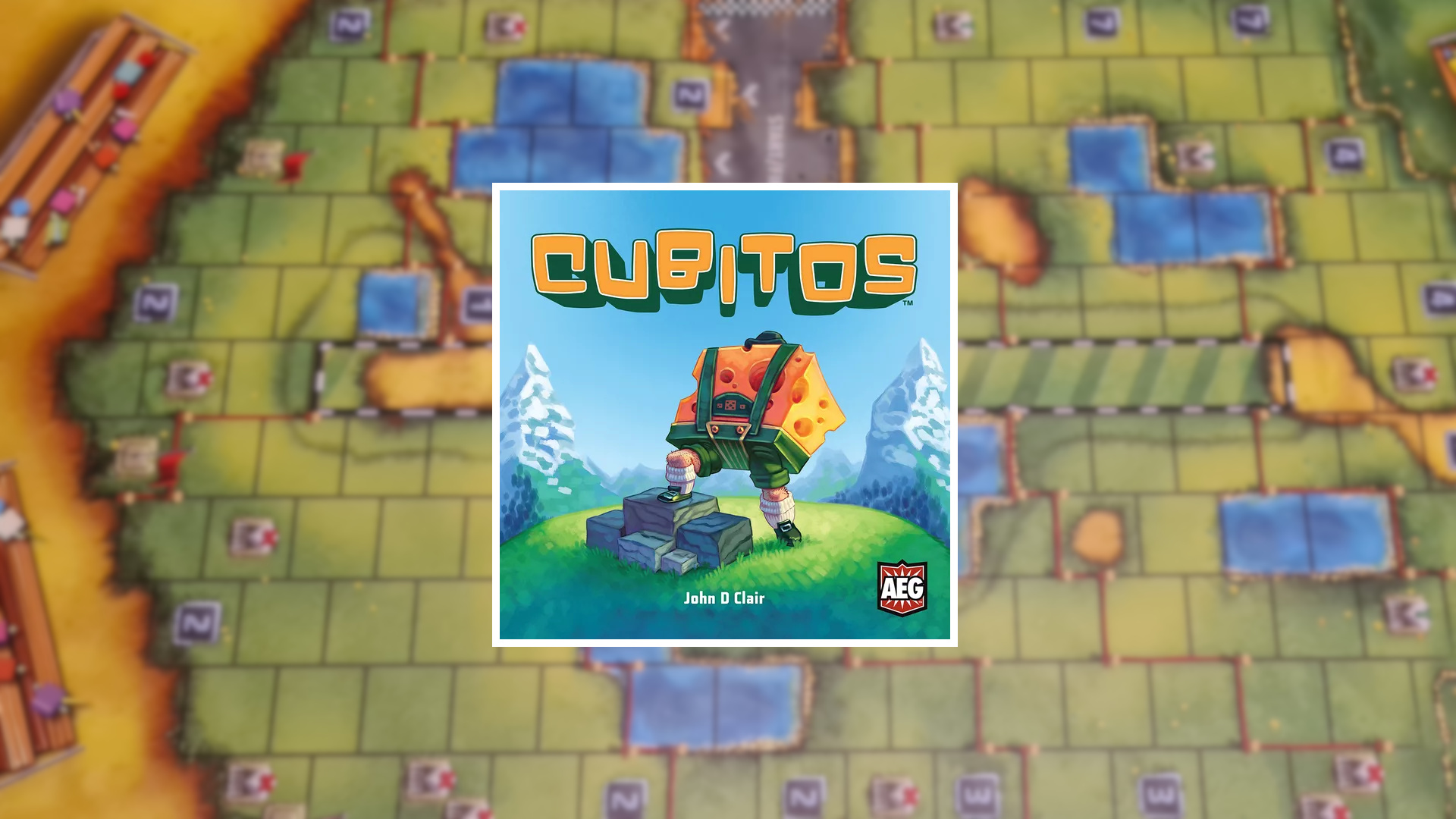Cubitos is the brand new dice based, family racing game from publisher Alderac Entertainment Group (AEG). Designed by John D. Clair, featuring artwork from Jacqui Davis, Philip Glofcheskie and Ryan Iler, the game sees 2 – 4 players building up a pool of dice and utilizing them to rocket around a racetrack. Playing in around 45 minutes, players will push their luck, gain new better dice and trigger abilities. However, should this be rolling into your collection? Let’s find out!
The first thing when playing Cubitos is to decide which track to play on. The first track, Nothing Goes Right, is considered the easiest – with 4 different tracks to choose from. Following this players can either randomly select a card for each of the 8 ability dice colours, or follow the various predetermined sets in the rulebook.
Each player then takes two runners of their chosen colour, placing one on the start line of the racetrack and the other on the bleachers sideboard. They also take a player board, phase reminder token, 7 Light gray starting dice and 2 Dark gray starting dice. Boxes of the coloured ability dice are put nearby, with their assigned cards. The game is then ready to begin, with a random player claiming the first player bonus die.
The game is played until someone crosses the finish line, singling the final round. Each round is split into two distinct phases, helpfully tracked by the phase token. First is the roll phase, followed by the run phase. In the roll phase players take dice from their draw zone and, unsurprisingly, roll them. The amount of dice depends on a couple of factors – such as the position of others in the race. Those behind get to draw an additional die for each ribbon on the track they are behind. By default though players draw 9 dice – which just happens to be all of their starting dice.
The rolling is the push your luck aspect of Cubitos. Most of the dice in the game have 3 or more blank faces, being classed as missed when rolled. Rolling all of your drawn dice players move any hits, non-blank faced rolled dice, into their Active Zone. Players can then reroll all of the blank faced misses in their roll zone. However, if a player has had 3 or more hits that round and roll only misses they go bust.Of course players can choose to pass instead of re-rolling.

Going bust as you might expect isn’t helpful, though it’s not a completely voided round. Firstly, players unfortunately must discard all dice from their active zone – to the discard section of their player board. They can then choose to move any dice from their roll zone to their discard pile. In future rounds when drawing dice the number is reduced by the count of dice already in the roll zone. Finally, a busted player moves their runner one step off the bleachers along the fan track – which periodically offers bonuses.
When everyone has passed or busted play moves onto the run phase. First players trigger any ability dice, potentially gaining coins, movement points and more. Next, the non-bust players move their characters around the racetrack up to the value of the movement points. All players can at this stage spend multiples 4 money to advance a space on the track. After this, players can spend their money on new dice, being able to buy up to 2 different coloured dice. These get added to the player’s discard zone. When finished players slide any dice still in their active zone across to their discard pile.
A new round then begins, with players drawing dice. Note that the first player bonus die gets passed on clockwise. When a player’s draw pile runs out they shift all dice from their discard pile over to the draw pile and continue drawing dice. The race track has a few different benefits and obstacles for players to work with. Ending on specific spaces awards money, with others being potential shortcuts. Water spaces can disrupt movement, though some ability dice allow for movement across water. The game continues until one player crosses the finish line. If more than one player does this, whoever gets furthest across the line wins!
Cubitos includes many, many, dice. With 10 of each of the eight colours and then a huge pile of gray dice for players’ starting dice there are 120 included in the box. Whilst on the small side these aren’t fiddly and each colour has its own symbols appearing on the dice. Rather than rattle around the box, or be lumped in together, dice storage boxes are included – which aids the setup and teardown of the game. What makes these especially impressive is that these double as dice holders during the game, even showing on them the distribution of symbols on the faces of that coloured dice!
There are two types of money in Cubitos, not two currencies, just types. When buying dice or spending to move forward all money is equivalent. Circled money values are only temporary though, while squared money tokens can be claimed from a pile of tokens. This means that while equal 1 square money is slightly better than 1 circle money. It gives the player the flexibility to hold onto it for a later round, rather than either spend it or lose it. It’s a subtle difference but makes for some interesting choices when saving up for the big expensive but powerful dice.

Cubitos has seen comparisons drawn to the smash hit Quacks of Quedlinburg and it is the push your luck elements and the ability cards that cause this similarity. Being able to change out the abilities from one game to another keeps the experience fresh, with countless combinations possible. In one game the blue dice could represent Undercover Fish, which give 2 movement points which can be spent across water. In the next game the blue dice could represent Llama-Rama which gains the player 3 money and potentially sees the secondary runner move on the fan track. Sticking with the predetermined combinations of abilities is a great idea to get a set that works well together – but there’s nothing stopping players crafting their own selections!
Gaining dice is somewhat an addictive side to Cubitos. Slowly but surely increasing your dice pool feels good. However, there is a point where players need to shift their focus from gaining dice to powering around the course. As Cubitos is at heart a racing game, this should be easy for players but it turns out it is harder than it sounds. Much like when to try to pull out ahead, gifting those behind additional dice, when to stop trying for coins is an important choice.
The dice and their abilities instill so much variety. Alas, there are 4 different tracks for players to race around/along. It would have been nice for these to be somewhat modular though, or an extra double sided board included, just to bump up the track count. Even overlay token that could have added pools of water to avoid and such could have just spiced up the included tracks.
Cubitos takes a few rounds to get into. At first there’s so many different dice, each colour with its own ability. For some new players this is quite overwhelming. A few rounds in and players will start to see how the game ticks. At that point that large amount of dice, the amount of choice, becomes Cubitos’ brilliant core. There’s the fun of building up a pool of dice, getting to chunk all of them, pushing your luck for that one more coin or movement… risking and maybe going bust. It’s a huge amount of fun and once it’s hit the table it’ll keep returning!
(Editor’s Note: Cubitos was provided to us by Asmodee for the review. The game is currently available from local board game stores! Find your local store here.)

